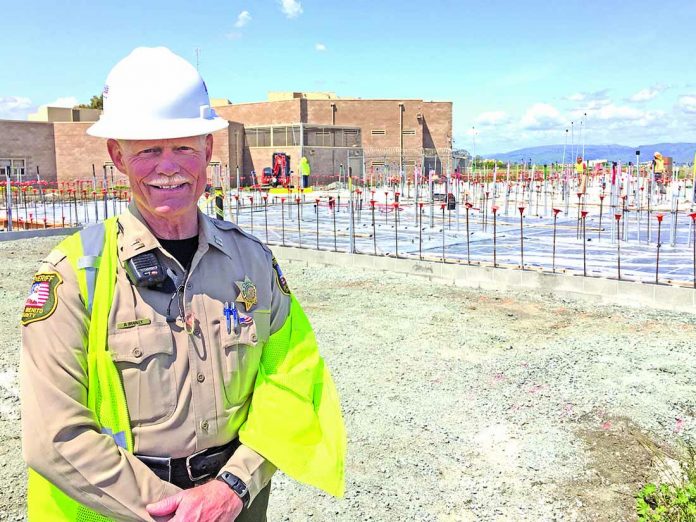
The expansion of the San Benito County Jail—which will increase the correctional facility’s housing capacity by about 50 percent—is well underway on Flynn Road in north Hollister. But the county has not yet budgeted all of the costs to open the jail and keep it operating when construction is complete.
The $22 million jail expansion project is designed to provide more space for inmates who are serving longer sentences than they used to, with expanded capacities for the inmate population’s growing medical and mental health needs, San Benito County Sheriff’s Capt. Don Bradley explained on a recent tour of the jail construction site. He also said the jail will offer educational opportunities aimed at equipping those inside with real-world skills they can use upon their release,
The jail expansion is a “podular” design directly adjacent to the current jail, with two two-story pods, each housing 36 inmates, Bradley said. The current facility, which is about 26 years old and in need of repairs, houses about 140 inmates. Last Thursday, April 12, there were 136 inmates at the county jail.
“It will take us several years to reach capacity, we hope,” Bradley said of the 22,000-square-foot expansion.
The new facility will also contain new space for health services for inmates, classrooms, outdoor recreation yards and a central control room similar to the one in the existing jail, but with modern technology.
Sheriff Darren Thompson, in a draft of the sheriff’s annual report, described the expansion design as a “medium security dorm style.”
Construction has been underway for about four months, and Bradley said contractors have about a year to go before the expansion is ready to open. They’re about 24 days behind on the contract, mostly due to weather-related delays.
Planning on the jail expansion began in 2007, when the county applied for and received $15 million for the project under the state AB900 law. The county will likely be required to match up to $7 million of local funds to fully finance the project which “will meet San Benito’s needs for the next 30 to 40 years,” according to Board of Supervisors Chair Anthony Botelho.
“San Benito County is the envy of many other counties that are still on a waiting list (for AB900 funds) and the county has worked on this project for a number of years,” Botelho said. He noted that the project started under former Sheriff Curtis Hall’s leadership, with Thompson continuing the effort.
Bradley noted that increasing costs of construction materials—notably steel—since 2007 have raised the overall projected price tag for the expansion, from what was once estimated at less than $20 million.
Currently, the county has not fully funded new staffing requirements for the larger facility, but Botelho said they are required by law to adequately staff the jail.
Bradley, a law enforcement retiree who is working as the sheriff’s part-time Special Projects Captain overseeing the jail expansion, said the new facility will need at least five additional correctional officers and one civilian Staff Services Specialist. That is, if they can connect the old jail’s control room with that of the new facility, creating a single security system for the entire property.
However, the technology in the old jail is not compatible with that proposed for the new facility, and staff are still working on an effort to combine the two, Bradley said. If they can’t connect the two control rooms, staffing needs will increase.
The county’s 2017-18 budget lists the hiring of four additional officers to staff the new jail as a “long-range planning goal” for the sheriff’s office. That adds up to well over $500,000 for a full year’s salaries and benefits for four officers—with the county on the hook for most of that amount—and rising if more staff positions are needed. The current jail has a staff of 26, according to the 2017-18 county budget.
Those funds have not yet been budgeted. Sheriff’s staff and the board of supervisors will consider the expenses in the coming weeks as the five-member board determines the 2018-19 budget.
“I am confident the county will be able to meet the financial requirements of the new jail expansion,” Botelho said. “Finding qualified recruits may be more troublesome in the very tight job market.”
Rehab vs. incarceration
Since the county gained state funding for the jail project in 2007, additional state laws—such as AB109 and Proposition 47—have drastically affected correctional institutions and inmate requirements throughout California.
In San Benito County, the jail population used to be significantly comprised of lower-level offenders serving sentences of one year or less. The average sentence in San Benito County Jail was 33 days before AB109 became law in 2011.
“Now, they’re serving five to seven years, with more medical and mental health needs,” Bradley said. Longer sentences are related to the state’s effort to reduce the prison population by shifting responsibility for certain felony offenders—as well as their medical and mental health needs—from state facilities to local jails.
Bradley added, “This is pretty much a felony facility. If you’re a low-level offender, you’re out on the street” with monitoring or probation.
The new state correction laws also offer more educational opportunities to inmates, allowing them to work toward reducing their sentences. The San Benito County Jail expansion is designed to accommodate those efforts. Inmates who participate in education programs can work on digital tablets to earn credits toward a high school diploma, or even a Bachelor’s degree. Staff is also looking at implementing apprenticeship programs to start inmates in trades like electrical or horticulture.
In addition to reduced sentences, inmates can also gain “perks” for good behavior such as using tablets for movies or other entertainment.
The current jail offers some education and counseling, but not a modern tablet-based program or significant space for classes, Bradley explained. The expansion is geared more toward “rehabilitation than incarceration.”
“The main idea is to reduce recidivism,” Bradley said. “If we can give people marketable job skills or critical thinking abilities, they will be better equipped to help themselves.”
Botelho added, “Society needs to invest more in these programs to break the cycle of crime. Some of the programs that (are) being worked on by many of the county departments and (the City of) Hollister would help some folks that we find in our jail.”
The current jail will continue to house inmates after the expansion is complete, but portions of the building will be “repurposed” for other jail functions such as probation and monitoring services, work furlough programs and administrative functions.
The county’s jail transition team will continue to work on those details as the completion of the expansion approaches over the next year.









